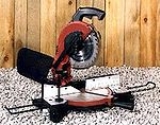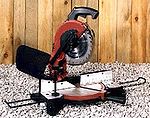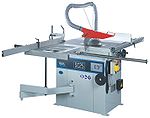
Circular saw
Encyclopedia

Metal
A metal , is an element, compound, or alloy that is a good conductor of both electricity and heat. Metals are usually malleable and shiny, that is they reflect most of incident light...
cutting disc
Disk (mathematics)
In geometry, a disk is the region in a plane bounded by a circle.A disk is said to be closed or open according to whether or not it contains the circle that constitutes its boundary...
or blade
Blade
A blade is that portion of a tool, weapon, or machine with a cutting edge and/or a pointed tip that is designed to cut and/or puncture, stab, slash, chop, slice, thrust, or scrape animate or inanimate surfaces or materials...
. The term is also loosely used for the blade itself. The blade is a tool
Tool
A tool is a device that can be used to produce an item or achieve a task, but that is not consumed in the process. Informally the word is also used to describe a procedure or process with a specific purpose. Tools that are used in particular fields or activities may have different designations such...
for cutting wood
Wood
Wood is a hard, fibrous tissue found in many trees. It has been used for hundreds of thousands of years for both fuel and as a construction material. It is an organic material, a natural composite of cellulose fibers embedded in a matrix of lignin which resists compression...
or other materials and may be hand-held or table-mounted. It can also be used to make narrow slots (dados). Most of these saws are designed with a blade to cut wood but may also be equipped with a blade designed to cut masonry
Masonry
Masonry is the building of structures from individual units laid in and bound together by mortar; the term masonry can also refer to the units themselves. The common materials of masonry construction are brick, stone, marble, granite, travertine, limestone; concrete block, glass block, stucco, and...
, plastic
Plastic
A plastic material is any of a wide range of synthetic or semi-synthetic organic solids used in the manufacture of industrial products. Plastics are typically polymers of high molecular mass, and may contain other substances to improve performance and/or reduce production costs...
, or metal
Metal
A metal , is an element, compound, or alloy that is a good conductor of both electricity and heat. Metals are usually malleable and shiny, that is they reflect most of incident light...
. There are also purpose-made circular saws specially designed for particular materials. While today circular saws are almost exclusively powered by electricity, larger ones, such as those in "saw mills", were traditionally powered by water
Water
Water is a chemical substance with the chemical formula H2O. A water molecule contains one oxygen and two hydrogen atoms connected by covalent bonds. Water is a liquid at ambient conditions, but it often co-exists on Earth with its solid state, ice, and gaseous state . Water also exists in a...
turning a large wheel
Water wheel
A water wheel is a machine for converting the energy of free-flowing or falling water into useful forms of power. A water wheel consists of a large wooden or metal wheel, with a number of blades or buckets arranged on the outside rim forming the driving surface...
.

Process
Typically, the material to be cut is securely clamped or held in a viseVise (tool)
A vise or vice is a mechanical screw apparatus used for holding or clamping a work piece to allow work to be performed on it with tools such as saws, planes, drills, mills, screwdrivers, sandpaper, etc. Vises usually have one fixed jaw and another, parallel, jaw which is moved towards or away from...
, and the saw is advanced slowly across it. In variants such as the table saw
Table saw
A table saw or sawbench is a woodworking tool consisting of a circular saw blade, mounted on an arbor, that is driven by an electric motor...
, the saw is fixed and the material to be cut is slowly moved into the saw blade. As each tooth in the blade strikes the material, it makes a small chip. The teeth guide the chip out of the workpiece, preventing it from binding the blade.
Characteristics
- Cutting is by teeth on the edge of a thin blade
- The cut has narrow kerfKerfKerf and similar can mean:* kerf, the width of a cut* Kerf, a poetry collection by Peter Sanger* Kerala E.N.T. Research Foundation , a hospital at Kollam in Kerala in India...
and good surface finish - Cuts are straight and relatively accurate
- The saw usually leaves burrs on the cut edge
- Saw setting should be done geometrically.
Invention
Various claims have been made as to who invented the circular saw:- A common claim is for a little known sailmaker named Samuel Miller of SouthamptonSouthamptonSouthampton is the largest city in the county of Hampshire on the south coast of England, and is situated south-west of London and north-west of Portsmouth. Southampton is a major port and the closest city to the New Forest...
, England who obtained a patent in 1777 for a saw windmill. However the specification for this only mentions the form of the saw incidentally, probably indicating that it was not his invention. - Gervinus of Germany is often credited with inventing the circular saw in 1780
- Walter TaylorWalter Taylor (Southampton)Walter Taylor of Southampton, supplied wooden rigging blocks to the Royal Navy, greatly improving their quality via technological innovations which were a significant step forward in the Industrial Revolution....
of Southampton had the blockmakingBlock (sailing)In sailing, a block is a single or multiple pulley. One or a number of sheaves are enclosed in an assembly between cheeks or chocks. In use a block is fixed to the end of a line, to a spar or to a surface...
contract for Portsmouth DockyardHMNB PortsmouthHer Majesty's Naval Base Portsmouth is one of three operating bases in the United Kingdom for the British Royal Navy...
. In about 1762 he built a saw mill where he roughed out the blocks. This was replaced by another mill in 1781. Descriptions of his machinery there in the 1790s show that he had circular saws. Taylor patentPatentA patent is a form of intellectual property. It consists of a set of exclusive rights granted by a sovereign state to an inventor or their assignee for a limited period of time in exchange for the public disclosure of an invention....
ed two other improvements to blockmaking but not the circular saw. This suggests either that he did not invent it or that he published his invention without patenting it (which would mean it was no longer patentable). - Another claim is that it originated in Holland in the sixteenth or seventeenth century. This may be correct, but nothing more precise is known.
- The use of a large circular saw in a saw mill is said to have been invented in 1813 by Tabitha Babbit, a Shaker spinster, who sought to ease the labour of the male sawyers in her community.
- The Barringer, Manners and Wallis factory in Rock Valley Mansfield, Nottinghamshire also claims to be the site of the invention.
Types of circular saw
In addition to hand-held circular saws (see below), different saws that use circular saw blades include:- Miter sawMiter sawA miter saw is a saw used to make accurate crosscuts and miters in a workpiece.-Manual miter saw:The basic miter saw is the manual miter saw. It is a saw suspended on rollers in a metal guide that works with a miter box that allows making accurate crosscuts and miter cuts...
s (or Chop saw or Cut-off saw) - Radial arm sawRadial arm sawA radial arm saw is a cutting machine consisting of a circular saw mounted on a sliding horizontal arm. Invented by Raymond De Walt in 1922, the radial arm saw was the primary tool used for cutting long pieces of stock to length until the introduction of the miter saw in the 1970s.In addition to...
s - Saw mills
- Table sawTable sawA table saw or sawbench is a woodworking tool consisting of a circular saw blade, mounted on an arbor, that is driven by an electric motor...
s - Panel sawPanel sawA panel saw is any type of sawing machine that cuts sheets into sized parts. Panel saws are used by cabinet shops to easily cut plywood and melamine sheets into cabinet components. They are also used by sign shops to cut sheets of aluminum, plastic and wood for their sign blanks. Panel saws...
s - Biscuit joinerBiscuit joinerA biscuit joiner or sometimes plate joiner is a woodworking tool used to join two pieces of wood together. A biscuit joiner uses a small tungsten carbide tipped, circular saw blade to cut a crescent shaped hole in the opposite edges of two pieces of wood or wood composite panels...
s - Pendulum saw
- Brushcutter
- Cold sawCold sawA cold saw is a sawing machine that uses a circular saw blade to cut metal. The name "cold saw" comes from the cutting process they employ. These sawing machines transfer the heat generated by cutting to the chips created by the saw blade...
s - Flip Over Saws (the Combination of a Compound Miter and Table saw)
Sawmill blades

After 1813 or 1822 saw mills use large circular saws, up to nine feet (2.97 m) in diameter. Large saws demand more power than up-and-down saws and did not become practical for sawing timbers until they were powered by steam engines. They are either left or right-handed, depending on which side of the blade the plank falls away from. Benching determines which hand the saw is. Saws of this size typically have a shear pin
Shear pin
A shear pin is a safety device designed to shear in the case of a mechanical overload, preventing other, more-expensive parts from being damaged...
hole, off axis, that breaks if the saw is overloaded and allows the saw to spin free. The most common version is the ITCO (insert tooth cut-off) which has replaceable teeth. Sawmill blades are also used as an alternative to a radial arm saw.
Cordwood saws
Cordwood saws, also called buzz saws in some locales, use blade of a similar size to sawmills. Where a sawmill rips (cuts with the grain) a cordwood saw crosscuts (cuts across the grain). Cordwood saws can have a blade from 20 to more than 36 inches (914.4 mm) diameter depending on the power source and intended purpose. Buzz saws are used to cut long logs (cordwood) and slabs (sawmill waste) into pieces suitable for home heating (firewood).Most cordwood saws consist of a frame, blade, mandrel, cradle, and power source. The cradle is a tilting or sliding guide that holds logs during the cutting process. Some cordwood saws are run from a belt from a farm tractor power takeoff pulley. Others are equipped with small gasoline engines or even large electric motors as power sources. The mandrel is a shaft and set of bearings that support and transfer power to the blade. The frame is a structure that supports the cradle and blade at a convenient working height.
Cordwood saws were once very popular in rural America. They were used to cut smaller wood into firewood in an era when hand powered saws were the only other option. Logs too large for a cordwood saw were still cut by hand. Chainsaws have largely replaced cordwood saws for firewood preparation today. Still, some commercial firewood processors and others use cordwood saws to save wear and tear on their chainsaws. Most people consider cordwood saws unsafe and outdated technology.
Hand-held circular saws
The term circular saw is most commonly used to refer to a hand-held electric circular saw designed for cutting wood, which may be used less optimally for cutting other materials with the exchange of specific blades. Circular saws can be either left or right-handed, depending on the side of the blade where the motor sits and which hand the operator uses when holding a saw.Blades for timber are almost universally tungsten carbide
Tungsten carbide
Tungsten carbide is an inorganic chemical compound containing equal parts of tungsten and carbon atoms. Colloquially, tungsten carbide is often simply called carbide. In its most basic form, it is a fine gray powder, but it can be pressed and formed into shapes for use in industrial machinery,...
tipped (TCT). High speed steel (HSS) blades are also available. The saw base can be adjusted for depth of cut. Adjusting the depth of cut helps minimize kickback. The saw base can also be adjusted to tilt up to 50 degrees in relation to the blade.
The saw can be designed for the blade to mount directly to the motor
Electric motor
An electric motor converts electrical energy into mechanical energy.Most electric motors operate through the interaction of magnetic fields and current-carrying conductors to generate force...
's driveshaft
Driveshaft
A drive shaft, driveshaft, driving shaft, propeller shaft, or Cardan shaft is a mechanical component for transmitting torque and rotation, usually used to connect other components of a drive train that cannot be connected directly because of distance or the need to allow for relative movement...
(known colloquially as a sidewinder), or be driven indirectly by a perpendicularly-mounted motor via worm gears, garnering considerably higher torque (Worm-drive saws).
The worm-drive portable circular saw was invented in 1923 by Edmond Michel. In 1924 Michel formed a partnership with Joseph Sullivan, and together they started the Michel Electric Handsaw Company, with the sole purpose of manufacturing and marketing the saw invented by Michel. The company later renamed itself Skilsaw Inc., which today is a subsidiary of Robert Bosch GmbH
Robert Bosch GmbH
Robert Bosch GmbH is a multinational engineering and electronics company headquartered in Gerlingen, near Stuttgart, Germany. It is the world's largest supplier of automotive components...
. Portable circular saws are often still called Skilsaws or Skil saws. Its successor is still sold by Skil as the model 77. To get around the Skil patents, Art Emmons of Porter-Cable
Porter-Cable
Porter-Cable is an American company that manufactures power tools. The company is known for introducing a number of noteworthy power tools, such as the first portable belt sander, helical-drive circular saw, and portable band saw. It is a subsidiary of Stanley Black & Decker.- History :Porter-Cable...
invented the direct-drive sidewinder saw in 1928. Recently smaller cordless
Cordless
The term cordless literally means without a cord and is generally used to refer to electrical or electronic devices that are powered by a battery or battery pack and can operate without a power cord or cable attached to a fixed electricity supply such as an outlet, generator, or other centralized...
circular saws with rechargeable batteries have become popular.

